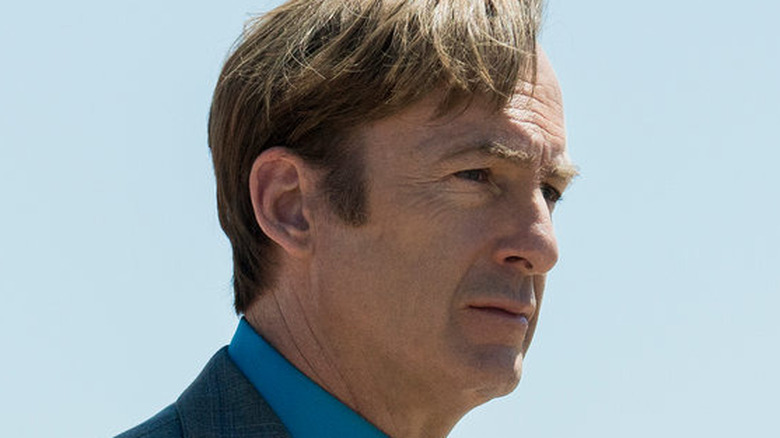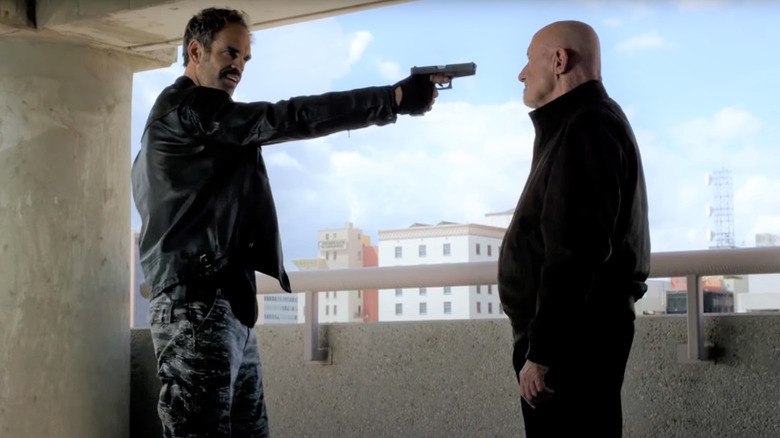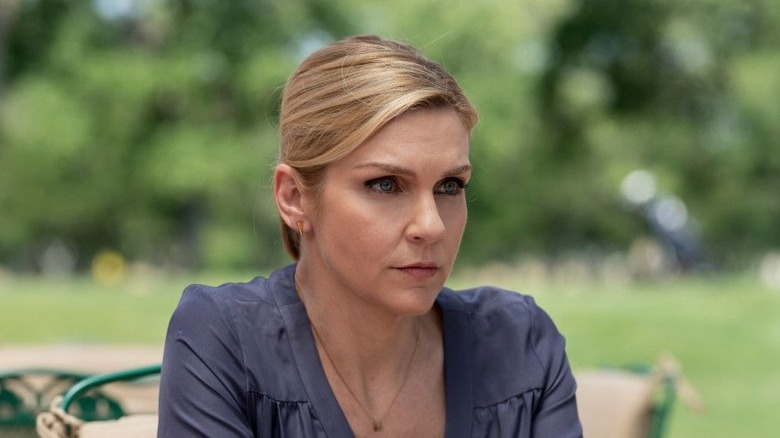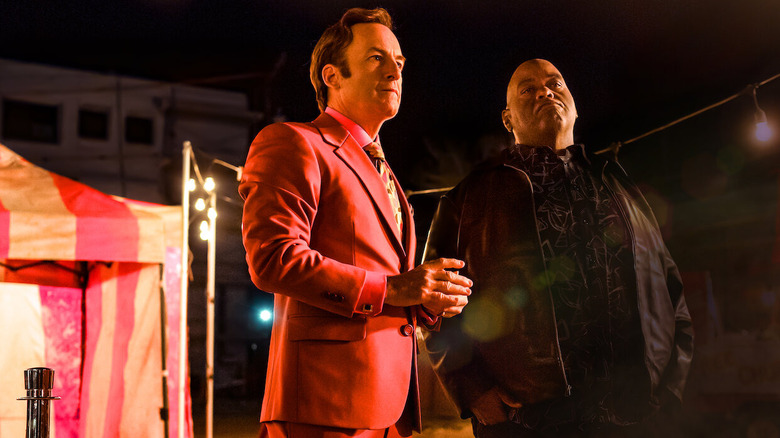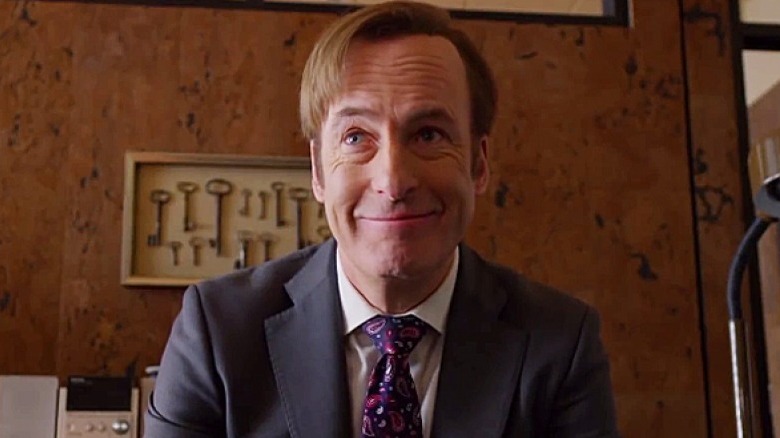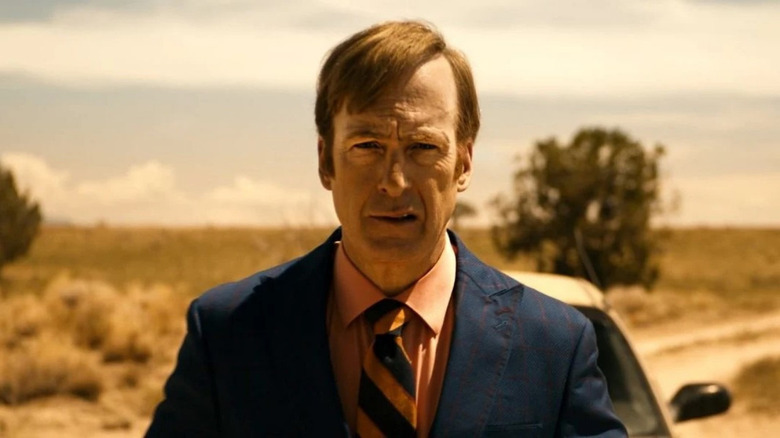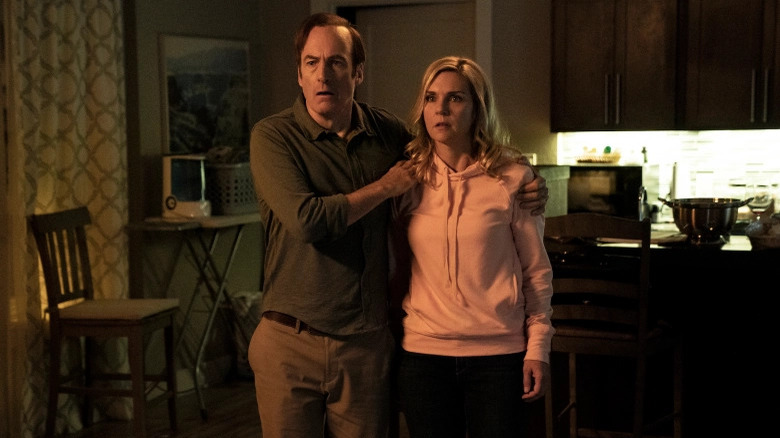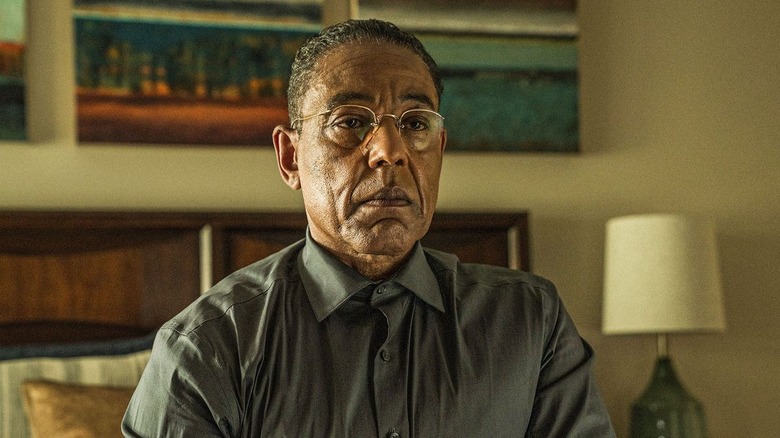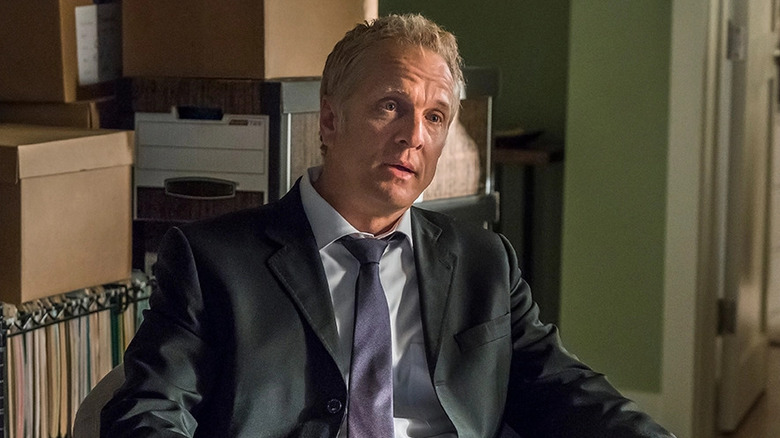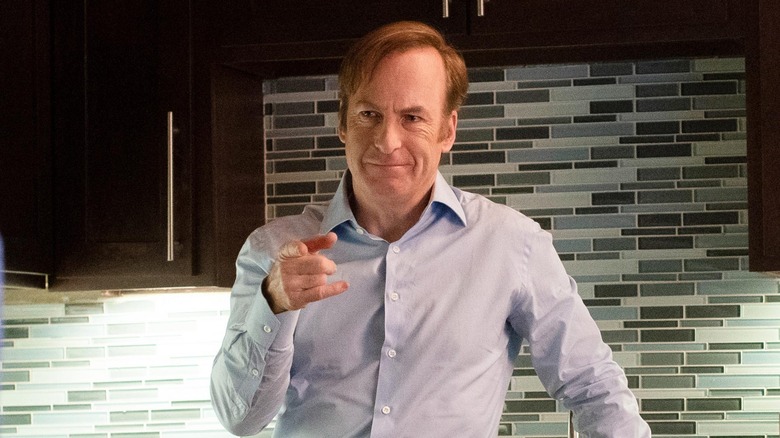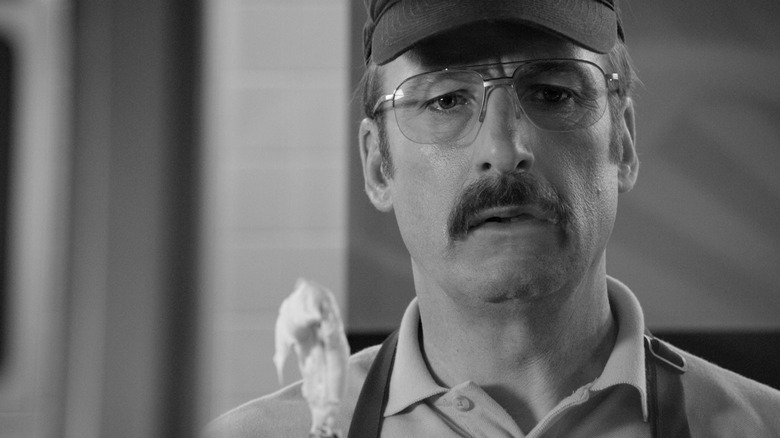Things Better Call Saul Does Better Than Breaking Bad
Spinning out of the acclaimed crime drama "Breaking Bad," the prequel television series "Better Call Saul" has garnered widespread acclaim as it charts the transformation of unscrupulous lawyer Jimmy McGill into the smooth-talking Saul Goodman. Starring Bob Odenkirk (who reprises his fan-favorite "Breaking Bad" role), the show has earned dozens of Emmy Award nominations across its six-season run as Jimmy finds himself getting into business with dangerous figures in his legal career. While "Breaking Bad" remains a landmark achievement in television storytelling, "Better Call Saul" has edged out its predecessor to stand as an even more impressive show.
More than simply expanding the "Breaking Bad" story, "Better Call Saul" is a rare example of a spinoff series that effectively stands on its own. Here are all the reasons why "Better Call Saul" has surpassed "Breaking Bad" to become one of the finest programs in television history, from its stellar ensemble cast to the production's increased technical prowess.
Better Call Saul is more tightly structured
By the end of "Breaking Bad," the creative team had gotten the pacing and structure of entire seasons and the individual episodes down to an exact science. Seemingly innocuous objects and actions had epic payoffs, while the series finale paralleled major elements from the premiere episode four seasons prior.
That attention to storytelling structure has only been further refined over the course of "Better Call Saul," and the creative team has only grown more effective.
From Mike Ehrmantraut (Jonathan Banks) laying a trap for passing vehicles from a rival drug cartel to Jimmy plotting how to rip off his latest mark, "Better Call Saul" meticulously sets up its payoffs. The attention to detail within the show is immaculate and practically demands repeat viewing to catch all the minute details viewers may have missed the first time around.
Rhea Seehorn is in a class all her own
It takes quite the actor to keep up with Bob Odenkirk's hyper-verbal Jimmy and Rhea Seehorn more than delivers on this expectation as Kim Wexler. An old friend of Jimmy's, Kim rises from her starting position in a law firm's mailroom to become a lawyer. The show presents Kim as a more responsible moral counterpoint to Jimmy as both lawyers begin to move up in the world. Being caught in Jimmy's self-destructive orbit endangers her career.
Over the course of the series, Seehorn has masterfully imbued Kim's character with depth. Seehorn balances Kim's professional drive with her wild side, which she explores through her relationship with Jimmy. It's one of the most captivating performances on the show. Showrunner Vince Gilligan has said that he hopes a hypothetical spinoff centered on Kim could potentially explore her character further.
Better Call Saul has better cinematography
There is some truly gorgeous cinematography in "Breaking Bad," especially in the show's latter seasons, but somehow "Better Call Saul" goes above and beyond to improve upon it. Part of this shift is due to the differences in locations between the two series, with "Breaking Bad" generally being a more claustrophobic story for much of its run. Conversely, quite a bit of "Better Call Saul" takes advantage of the sweeping New Mexico landscape and the dingier corners of Albuquerque where the show is filmed.
More than just variance in setting, much of "Better Call Saul" takes place at night and the cinematography inventively stages lighting and darkness in these sequences to set the mood and further the story. Cinematography plays a vital role in the show's storytelling itself.
By the end of "Breaking Bad," the crew was very much at the top of their technical game. Although the crew on "Better Call Saul" is different, their proficiency has only grown throughout production. They will go to great lengths to create the right texture, even hiring dancers to coordinate the opening sequence of Season 6.
Better Call Saul subverts Breaking Bad's character arc
Across its five seasons, "Breaking Bad" traced high school chemistry teacher Walter White's journey from a caring family man to a drug dealer and criminal mastermind. While there is debate if the show was about a good man going bad or Walter simply embracing his true nature, he definitely changed by the end of the series. Although "Better Call Saul" tracks Jimmy McGill's transformation into Saul Goodman, his arc isn't as simple as a switch from good to bad.
To the frustration of his older brother and those close to him, Jimmy has been a lifelong ne'er-do-well, unable to stop himself from taking advantage of others however he can. However, Jimmy's conscience and complicated morals keep his unscrupulous tendencies in check. He's a bad man trying to be good but trapped in his old ways. The expectation for Walter White to break bad is right there in his show's title, whereas Jimmy's arc is far more nuanced.
Better Call Saul's tone is perfectly balanced
For all the personal drama and bloody stakes, "Breaking Bad" possessed a wickedly dark sense of humor that would occasionally surface over the course of the series. As the show progressed, these moments became fewer and farther between, as Walter and Jesse endured their own devastating consequences for the lives they had chosen. This made the last stretch of the episodes particularly intense and bleak tonally as the series came to its gripping finale.
"Better Call Saul" certainly has its tense moments, but the overall tone of the show is better balanced than its predecessor, keeping more in line with Jimmy's wry wit. "Better Call Saul" delivers a genuine sense of narrative stakes but occasionally pulls up to allow its audience to breathe. While the series' creative team had initially considered making "Better Call Saul" more of a comedy, their decision to pivot it towards tonally balanced drama worked out much better.
Better Call Saul is a masterclass in tension
From taut standoffs with the authorities and rival criminals, "Breaking Bad" was an incredibly tense series, often punctuated by bloody violence as Walter and Jesse's illegal drug enterprise grew. This mounting tension has not only carried over to "Better Call Saul" but has also been enhanced by the creative team. Narrative tension is employed even in seemingly mundane sequences, from Jimmy's underhanded antics to his later life trying to live incognito in Nebraska. Who would have thought scenes set at a suburban Cinnabon could be so compelling?
The tension also escalates as Jimmy becomes increasingly embroiled with the organized crime element in Albuquerque. With the introduction of the unpredictably lethal antagonist Lalo Salamanca (Tony Dalton), every scene involving the Salamanca family has the threat of imminent violence hovering overhead. While audiences may think they know where Jimmy's story is going ahead of the events of "Breaking Bad," "Better Call Saul" keeps its own narrative full of twists and turns.
Better Call Saul brings back Breaking Bad's best villains
"Breaking Bad" had Walter White and Jesse Pinkman square off against some truly memorable antagonists. They often dispatch their enemies with lethal aplomb over the course of the series. While many of these villainous deaths made sense in the show's larger story, they also left the audiences wanting more from these fascinating figures. Taking place earlier in the shared timeline, "Better Call Saul" not only brings back several of these nefarious characters but does it in ways that feel organic to its own story.
Tuco Salamanca (Raymond Cruz), who was killed off early in "Breaking Bad" Season 2, was reintroduced in the inaugural season of "Better Call Saul," just as volatile and angry as ever. "Better Call Saul" also brought back the fearsome Hector Salamanca (Mark Margolis) and Gus Fring (Giancarlo Esposito) as the two local crime lords controlling their own corners of Albuquerque. These returning antagonists not only gave audiences more time with the fan-favorite characters but provided a greater look into their respective backstories before their "Breaking Bad" appearances.
Better Call Saul has a stronger ensemble cast
To be clear, "Breaking Bad" has a stellar ensemble cast supporting series leads Bryan Cranston and Aaron Paul, with actors like Anna Gunn and Dean Norris elevating the show. However, "Better Call Saul" has a much better idea of what to do with its cast, especially as regards the various characters Jimmy spars with outside the courtroom. From Michael McKean as Jimmy's long-suffering brother Chuck to Patrick Fabian as Chuck's longtime colleague Howard Hamlin, "Better Call Saul" has brought some truly compelling characters to the overarching story.
Some of the subplots for the supporting characters in "Breaking Bad" felt forced, such as Marie (Betsy Brandt) descending into unrepentant kleptomania whenever she felt neglected by her husband Hank. "Better Call Saul" understands that not every major character needs their own quirk or foible in order to establish depth and nuance while maintaining its tight focus. The supporting cast lifts "Better Call Saul" to stratospheric heights.
Better Call Saul is perfectly fine as a standalone show
So many spinoff series fall into the narrative trap of being overly reliant on the shows that they spun off from in the first place, be it "AfterMASH" or "Fuller House." This inhibits the spinoff from developing its own identity, since it's too beholden to what came before to confidently forge ahead. Fortunately, "Better Call Saul" has had no problem distinguishing itself from "Breaking Bad" and becoming its own celebrated show.
This isn't to say there aren't clear links between "Better Call Saul" and "Breaking Bad." Those connections and nods are present right from the first season. However, these returning elements and references feel earned. They're also subtle enough that anyone who hasn't seen "Breaking Bad" won't be completely lost, and the drama unfolding is engaging enough on its own merits without these callbacks. Both "Breaking Bad" and "Better Call Saul" follow the criminal element in Albuquerque but from significantly different perspectives, so they feel more complementary to one another than derivative.
Better Call Saul builds on a longstanding mystery
While the bulk of "Better Call Saul" takes place before the events of "Breaking Bad," the spinoff features a recurring framing device that takes place sometime after the "Breaking Bad" series finale. Jimmy lives incognito in Nebraska and holds down a mundane job at a Cinnabon. His past life as Saul Goodman is constantly at risk of catching up to him—with dire consequences. Each season includes a glimpse of Jimmy's sad, lonesome life in Nebraska, while steadily building up the paranoia that his truth will be exposed.
These moody, black-and-white flash-forward sequences remind audiences that they know where Jimmy's morally checkered legal career will ultimately lead him. Even with Jimmy presumably flying under the radar, these scenes are still worrying enough to make audiences question if Jimmy got his clean getaway. This framing device addresses the mystery of how he handled his fall from grace.
